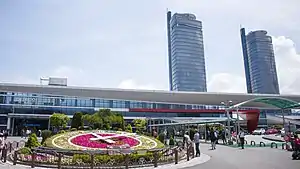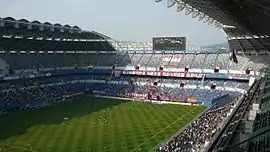Daejeon
Daejeon (Korean: [tɛd͡ʑʌn] ⓘ) is South Korea's fifth-largest metropolis, with a population of 1.5 million as of 2019.[2] Located in a central lowland valley alongside forested hills and the Geum River, the city is known for its technology and research institutions, and for celebrating its natural environment, with most mountains, hot springs, and rivers freely open for public use.[3][4] Daejeon serves as a hub of transportation for major rail and road routes, and is approximately 50 minutes from the capital, Seoul, by KTX or SRT high speed rail.[5]
Daejeon
대전 | |
|---|---|
| Daejeon Metropolitan City 대전광역시 | |
| transcription(s) | |
| • Hangul | 대전광역시 |
| • Hanja | 大田廣域市 |
| • Revised Romanization | Daejeon-gwangyeoksi |
| • McCune-Reischauer | Taejŏn-kwangyŏksi |
Clockwise from top: view of Daejeon from Bomunsan Mountain; Daejeoncheon; Government Complex Daejeon; Uam Historic Park; and Daejeon Station | |
 Flag 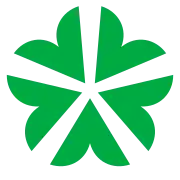 Logo | |
 | |
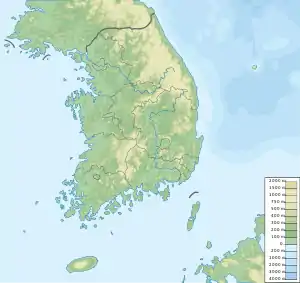 Daejeon | |
| Coordinates: 36°21′00″N 127°23′06″E | |
| Country | South Korea |
| Region | Hoseo |
| Districts | 5 |
| Government | |
| • Type | Mayor–council |
| • Mayor | Lee Jang-woo (People Power) |
| • Body | Daejeon Metropolitan Council |
| Area | |
| • Total | 539.85 km2 (208.44 sq mi) |
| Population (January 2022) | |
| • Total | 1,469,543 |
| • Density | 2,700/km2 (7,100/sq mi) |
| • Dialect | Chungcheong |
| Gross Regional Product (2020) | |
| • Total | KR₩44.4 trillion US$35.5 billion |
| ISO 3166 code | KR-30 |
| Flower | White magnolia |
| Tree | Pine |
| Bird | Korean magpie |
| Website | daejeon.go.kr |
Daejeon (along with Seoul, Gwacheon and Sejong City) is one of South Korea's administration hubs. The city is home to 23 universities and colleges, including Korea Advanced Institute of Science and Technology (KAIST) and Chungnam National University, as well as government research institutes, and research and development centers for global companies such as Samsung, LG, mostly located in the city's Daedeok Science Town.[6][7]
Occupied by humans since the Stone Age, Daejeon was historically a collection of small riverside villages.[8] Though the area had varying degrees of strategic importance depending on the period in history, it was largely undeveloped until its use as a rail hub from the early 1900s, during the period of Japanese occupation.[9] From the 1980s, multiple national administrative functions were moved from Seoul to Daejeon, most of which are now located in the Daejeon Government Complex, resulting in another population increase.[10] The city hosted the 1986 Asian Games, the Taejon Expo '93, the International Mathematical Olympiads in 2000, and was elevated to the status of Metropolitan City in 2005.[11][12]
Daejeon is situated in a lowland valley with three major rivers, all of them eventually flowing into the Yellow Sea by way of the Geum river. The city is surrounded by several small mountains, and is located approximately 170 km (105.6 mi) south of Seoul and 290 km (180 mi) north of Busan, and 70 km (43 mi) east of the Yellow Sea.[13] Daejeon experiences a monsoon-influenced, four-season climate with wet, hot summers and drier, cold winters.
History
Human beings first settled in the Daejeon region during the Stone Age. It was occupied and in use as strategic military ground in various times by people such as the Usul-gun of Baekje, Bipung-gun of Silla, and the Hoideok-hyeon, Yuseong-hyeon, Deokjin-hyeon, and Jinjam-hyeon. During the Joseon Kingdom period, it remained occupied by the Hoideok-hyeon and Jinjam-hyeon of Gongju Mokha. In 1895, most of the area was made part of Hoideok-gun and Jinjam-gun, excluding some parts that belonged to Gongju-gun.
The Daejeon area was historically known as Hanbat (한밭),[14] a native Korean term for "large field", during the Joseon Dynasty. "Daejeon" simply means the same thing in Hanja. In the 19th century, Daejeon was also known in English as Kung-tsiou.[15]
Historically, Daejeon was a small village without many residents. However, in 1905, the Gyeongbu Railway began operations from Seoul to Busan, opening a station at Daejeon. In 1926 under the rule of the Japanese government, the Honam Railway was built between Mokpo and Daejeon, transforming the latter into a major transportation hub. Because of its location and proximity to means of transportation, Daejeon grew quickly.[9]
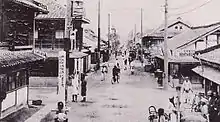
As railroads were laid under Japanese rule, an environment friendly to the Japanese was created, and many Japanese began to settle in Daejeon taking advantage of the opportunity. According to 1910 census data, 58%, or more than half of the 4,350 Daejeon population at the time, were Japanese. In 1925, 56% of the 8,861 people in Daejeon were Japanese. Therefore, Daejeon was one of the cities with great cultural influence of Japanese residents. For example, elderly people who experienced Japanese colonial era pronounce '단무지' (Pickled radish, danmuji) as '닥광/단광'(dakgwang/dangwang), '컵' (cup, keob) as '고뿌' (goffu) and '비닐' (vinyl, binil) as '비니루' (binilu). In addition, '우에시다리' (Uesidari), a representative team division game in Daejeon, was also created at this time and is believed to have been derived from the Japanese word '上(うえ, Ue)' meaning 'up' and the Japanese word '下(した, sita)' meaning 'down'.[16]

In 1932, the capital of South Chungcheong Province was moved from Gongju to Daejeon. During the Korean War, the city was the site of an early major conflict: the Battle of Taejon. Also during the war, the mass graves of civilians killed by South Korean police were discovered near Taejon and reported on by Alan Winnington in his famous anti-war leaflet "I Saw Truth in Korea".[17][18] Embarrassed by the contents of the leaflet, the British government considered having him executed for treason, though instead decided to make him stateless.[19][20]
Since then, changes have been made to the city's boundaries. Its official names have evolved, as well. Among the boundary modifications include one that effectively made the nearby town of Daedeok a part of the city in 1983. Then, in the late 1980s, Daejeon was elevated to the status of Special City (Jikhalsi), thus became a separate administrative region from South Chungcheong Province. In 1995, all South Korean Special Cities were again renamed as Metropolitan Cities, which is reflected in the current official name of Daejeon, Daejeon Metropolitan City (대전광역시).[12]
In the 1980s, the Korean administration began moving various national government operations from Seoul to Daejeon, eventually opening the Daejeon Government Complex in 1997. Today, the national government offices in Daejeon include Korea Customs Service, Small and Medium Business Administration, Public Procurement Service, National Statistical Office, Military Manpower Administration, Korea Forest Service, Cultural Heritage Administration, Korean Intellectual Property Office, Korail, Korea Water Resources Corporation, Korea Minting and Security Printing Corporation and Patent Court of Korea.
The population of Daejeon increased dramatically as a result of the government center.[21] However, with the construction of Sejong Special Self-Governing City in 2013 for the division of capital functions and balanced local development, many of the public institutions that had previously headed to Daejeon were moved to Sejong, and many public institutions in Seoul were also moved to Sejong. With the launch of Sejong City, large-scale development began, resulting in infrastructure construction and large-scale apartment complexes. Sejong is located immediately north of Daejeon, and Daejeon citizens began to outflow to Sejong. As of July 2020, there was net outflow of more than 100,000 people from Daejeon to Sejong.
Geography
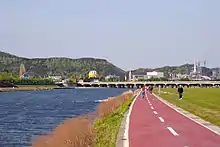
Daejeon lies between latitudes N36°10'59" and N36°30'1" and longitudes E127°14'48" and E127°33'35" near the middle of South Korea. It is 167.3 km (104.0 mi) from Seoul, 294 km (183 mi) from Busan and 169 km (105 mi) from Gwangju.
Known historically as 'big field,' the city lies inside a great circle surrounded by several mountains, with Gyeryongsan National Park straddling the city border on the west, and the foot of the Sobaek Mountain range just beyond the city to the south and east. Three rivers run through the center of the city: Gapcheon (갑천), Yudeungcheon (유등천), and Daejeoncheon (대전천). These flow roughly from south to north, eventually joining the Geum River which borders the city on the northeast. The river changes direction after leaving Daejeon, turning to the southwest and eventually emptying into the Yellow Sea near Gunsan.[22]
Climate
| Daejeon | ||||||||||||||||||||||||||||||||||||||||||||||||||||||||||||
|---|---|---|---|---|---|---|---|---|---|---|---|---|---|---|---|---|---|---|---|---|---|---|---|---|---|---|---|---|---|---|---|---|---|---|---|---|---|---|---|---|---|---|---|---|---|---|---|---|---|---|---|---|---|---|---|---|---|---|---|---|
| Climate chart (explanation) | ||||||||||||||||||||||||||||||||||||||||||||||||||||||||||||
| ||||||||||||||||||||||||||||||||||||||||||||||||||||||||||||
| ||||||||||||||||||||||||||||||||||||||||||||||||||||||||||||
Daejeon has a monsoon-influenced, four-season climate that lies between the humid subtropical and humid continental climatic classifications (Köppen Cwa/Dwa, respectively), with slightly more mild temperature extremes compared with Seoul. Winters are cold and dry with monthly mean temperature of −1.0 °C (30.2 °F) in January. Summers are hot and humid with a monthly mean temperature of 25.6 °C (78.1 °F) in August. The heaviest rainfall during the year typically occurs from July through August during the Korean monsoon season.[23]
| Climate data for Daejeon (1991–2020 normals, extremes 1969–present) | |||||||||||||
|---|---|---|---|---|---|---|---|---|---|---|---|---|---|
| Month | Jan | Feb | Mar | Apr | May | Jun | Jul | Aug | Sep | Oct | Nov | Dec | Year |
| Record high °C (°F) | 16.6 (61.9) |
22.6 (72.7) |
26.1 (79.0) |
30.4 (86.7) |
33.3 (91.9) |
35.7 (96.3) |
37.7 (99.9) |
39.4 (102.9) |
33.2 (91.8) |
31.2 (88.2) |
25.5 (77.9) |
18.4 (65.1) |
39.4 (102.9) |
| Average high °C (°F) | 4.1 (39.4) |
7.0 (44.6) |
12.7 (54.9) |
19.4 (66.9) |
24.5 (76.1) |
27.9 (82.2) |
29.6 (85.3) |
30.3 (86.5) |
26.3 (79.3) |
20.8 (69.4) |
13.5 (56.3) |
6.2 (43.2) |
18.5 (65.3) |
| Daily mean °C (°F) | −1.0 (30.2) |
1.4 (34.5) |
6.6 (43.9) |
13.0 (55.4) |
18.5 (65.3) |
22.7 (72.9) |
25.5 (77.9) |
26.0 (78.8) |
21.2 (70.2) |
14.6 (58.3) |
7.7 (45.9) |
1.0 (33.8) |
13.1 (55.6) |
| Average low °C (°F) | −5.5 (22.1) |
−3.6 (25.5) |
1.1 (34.0) |
6.9 (44.4) |
12.8 (55.0) |
18.1 (64.6) |
22.2 (72.0) |
22.5 (72.5) |
17.0 (62.6) |
9.4 (48.9) |
2.8 (37.0) |
−3.4 (25.9) |
8.4 (47.1) |
| Record low °C (°F) | −18.6 (−1.5) |
−19.0 (−2.2) |
−10.7 (12.7) |
−2.9 (26.8) |
3.1 (37.6) |
8.1 (46.6) |
13.0 (55.4) |
12.3 (54.1) |
4.2 (39.6) |
−2.9 (26.8) |
−11.4 (11.5) |
−17.7 (0.1) |
−19.0 (−2.2) |
| Average precipitation mm (inches) | 25.5 (1.00) |
37.2 (1.46) |
51.6 (2.03) |
81.6 (3.21) |
91.8 (3.61) |
167.3 (6.59) |
306.9 (12.08) |
299.8 (11.80) |
152.5 (6.00) |
59.3 (2.33) |
48.0 (1.89) |
29.7 (1.17) |
1,351.2 (53.20) |
| Average precipitation days (≥ 0.1 mm) | 8.0 | 7.0 | 8.3 | 8.3 | 8.2 | 9.9 | 16.4 | 14.8 | 9.1 | 6.1 | 8.5 | 9.3 | 113.9 |
| Average snowy days | 9.8 | 6.0 | 2.8 | 0.2 | 0.0 | 0.0 | 0.0 | 0.0 | 0.0 | 0.1 | 2.1 | 7.9 | 28.9 |
| Average relative humidity (%) | 65.3 | 60.3 | 57.9 | 56.9 | 62.4 | 69.8 | 79.1 | 78.2 | 75.3 | 71.8 | 69.3 | 67.9 | 67.9 |
| Mean monthly sunshine hours | 168.2 | 176.2 | 207.7 | 220.5 | 239.8 | 198.5 | 155.5 | 177.0 | 180.3 | 205.1 | 162.4 | 162.5 | 2,253.7 |
| Percent possible sunshine | 52.7 | 56.1 | 54.0 | 54.0 | 51.2 | 41.3 | 31.4 | 37.6 | 45.1 | 56.1 | 52.5 | 53.9 | 48.0 |
| Average ultraviolet index | 2 | 2 | 3 | 4 | 5 | 6 | 6 | 5 | 5 | 3 | 2 | 2 | 4 |
| Source 1: Korea Meteorological Administration (percent sunshine 1981–2010)[24][25][26] | |||||||||||||
| Source 2: Weather Atlas (UV)[27] | |||||||||||||
Administrative divisions

Daejeon is divided into five political "gu" or "districts": Seogu (서구), Donggu (동구), Yuseonggu (유성구), Daedeokgu (대덕구), and Junggu (중구).[28]
| Subdivision | Korean | Area (km2) | Population
(September 2021) |
|---|---|---|---|
| Daedeok District | 대덕구; 大德區 | 68.71 | 174,791 |
| Dong District | 동구; 東區 | 163.68 | 223,409 |
| Jung District | 중구; 中區 | 62.18 | 232,077 |
| Seo District | 서구; 西區 | 95.53 | 474,444 |
| Yuseong District | 유성구; 儒城區 | 176.53 | 350,337 |
Demographics

Daejeon is the fifth most populous city in Korea, with 1,467,468 registered residents as of 2023. The most populous district is Seo District (473,851 residents), although the district lost 32,219 residents since 2006, it remains the most densely populated in the city at 4,960 inhabitants per square kilometer (4,960/km2).[29]
As of 2023, the number of registered foreign residents in Daejeon was 21,949 (1.5% of the total population) with the largest representations being Vietnamese (0.5%), and Chinese or Korean-Chinese (0.2%). There are also smaller numbers of registered residents (0.1% or less in each case) from Uzbekistan, Mongolia, United States, Philippines, Indonesia, India, Japan, Thailand, Bangladesh, Nepal, Taiwan, Pakistan, Russia, France, United Kingdom, Canada, Germany, and Turkey.[30][29]
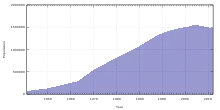
Religion
Religion in Daejeon (2005)[31]
According to the census of 2005, of the people of Daejeon, 21.8% follow Buddhism and 31.2% follow Christianity (20.5% Protestantism and 10.7% Catholicism).[31]
Education
There are 23 universities and colleges in Daejeon, concurrently enrolling around 90,000 students and employing 4,000 professors.[32]
Major public universities in Daejeon include:
- Chungnam National University, a major national university established for the South Chungcheong province. Chungnam National University brings expertise in biotechnology, medicine, and the agricultural sciences.
- Daejeon Chungnam University, a campus in the four-year Korea National Open University system.
- Hanbat National University, founded in 1927, specializing in partnerships between industry and academia.
- Korea Advanced Institute of Science and Technology (KAIST), the nation's first public research-oriented science and engineering institution. The university was ranked as the best Asian science and technology school by Asiaweek in 2000.[33] Strong fields at KAIST include computer science, electrical and nuclear engineering, mechanical design, chemistry, and telecommunications.
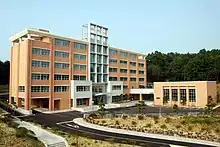

Major private universities in Daejeon include:
- Mokwon University
- Pai Chai University, founded in 1885, one of the oldest private universities in South Korea.
- Woosong University, specialized curriculum based on international exchange, foreign-language, and IT education.
- Hannam University, founded in 1956 by Christian missionaries, with a main campus in O-Jeong Dong (site of the historic Missionary Village), and a branch campus is in Techno Valley.
Specialized high schools and academies include:
- Daejeon Foreign Language High School is a selective high school focusing on teaching of foreign language. The school provides language education of 7 majors including English, German, French, Spanish, Chinese, Japanese, and Russian.
- Daejeon Science High School is a selective high school focused on teaching science.[34]
- Taejon Christian International School is an international school in the city.
Research and development
Daejeon is known as the research and development hub of Korea. In addition to KAIST and the Institute for Basic Science, it is home to more than 20 other government research institutions, and various corporate research centers, mostly located around Daedeok Innopolis in Yuseong District north of the Gapcheon river.[35][36]
Fields of research undertaken in Daejeon include telecommunications, nanofabrication, biotechnology, water, nuclear and hydro power, nuclear fusion, design, measurement technologies, mechanical engineering, fuel cells, aeronautics, new materials, robotics, new drugs, and environmental technologies. Daedeok Innopolis' membership includes 898 corporations, 35 government-invested and sponsored institutions; six universities, and 15 public organizations.

Research institutes in Daedeok include the Korea Research Institute of Bioscience and Biotechnology (KRIBB), the Korea Atomic Energy Research Institute (KAERI), Electronic and Telecommunications Research Institute (ETRI), Korea Aerospace Research Institute (KARI), Korea Astronomy and Space Science Institute (KASI), Korea Fusion Energy Research Institute (KFERI), National Nanofab Center, Korea Basic Science Institute (KBSI), Institute for Basic Science (IBS), Korea Institute of Machinery and Materials (KIMM), Korea Research Institute of Chemical Technology (KRICT), Korea Institute of Science and Technology Information (KISTI), Korea Research Institute of Standards and Science (KRISS), Marine and Ocean Engineering Research Institute, Institute of Information Technology Advancement (IITA), Korea Institute of Geosciences and Mineral Resources, Agency for Defense Development (ADD), Korea Institute of Toxicology (KIT), Korea Institute of Oriental Medicine, Korea Institute of Nuclear Non-proliferation and Control, National Institute for Mathematical Sciences (NIMS), Korea Institute of Nuclear Safety (KINS), Rare Isotope Science Project (RISP), National Research Foundation of Korea (NRF), and the National Security Research Institute. Among the technology produced in Daedeok are ETRI's wireless communications systems CDMA, WIBRO, and DMB, KRIBB's nano biochips, KARI's KOMPSAT satellites, and NFRI's KSTAR nuclear fusion experimental reactor.[37]
Daedeok is also home to 21 corporate research centers with global reach surrounded by an equal number of smaller firms. Some of the notable corporate research centers are Dongbu Advanced Research Institute (biotechnology, microorganisms and agrichemicals), GS-Caltex Value Creation Center (environmentally friendly products including substitutes for oil), Hanwha Chemical Research (biotechnology, electronics materials, catalysts, and nanotechnology), Honam Petrochemical Daeduk Research Institute (synthetic chemistry and petrochemicals), LG Chemical LTD. Research Park (lithium ion battery and polymer battery development), Samyang R&D Center (medical research and electronics), and SK Institute of Technology (petroleum-related research).
Public corporation research institutes such as Korea Electric Power Research Institute (hydroelectric projects and nuclear energy), Korea Institute of Construction Materials (authorized test agency for construction materials), and Korea Institute of Aerospace Technology (aerospace design, satellites, launch technologies) are also part of the Daedeok system.
On 16 May 2013, Daejeon was selected as the core of the International Science and Business Belt. [38]
Besides a tire production facility, Hankook Tire has its main R&D centre in Daejeon.[39]
Culture
Museums and arts centers
.jpg.webp)
Daejeon is the home of multiple arts and culture complexes, mostly centered around the Daedeok area. These include:
- Daejeon Museum of Art which hosts primarily technology-oriented modern and contemporary exhibitions
- Daejeon Arts Center which is home to local music and theater groups including the Daejeon Philharmonic Orchestra
- Laurent Beaudouin-designed Lee Ungno Museum, a large permanent collection of works by or related to the prominent Korean artist Lee Ungno[40][41][42]
- Expo Science Park, built on the grounds of the former international exposition (Taejŏn Expo '93) is home to the Institute for Basic Science and the National Science Museum, Korea's flagship science museum which features a main exhibition hall highlighting harmony between nature, man, and technology, as well as dedicated buildings related to natural history, future technology, biosphere, a children's science museum, and an astronomical observatory.[43][44][45][46]
- Geological Museum, belonging to the Korea Institute of Geoscience and Mineral Resources
- Daejeon Citizen's Observatory which houses a 10-inch refracting telescope and is the first citizen observatory in Korea[47][48]
Other arts spaces in the city include the six-floor Daejeon Artist House, performing arts center, and the Natural Ecology Center at Daecheong Lake.[49][50]
Parks and nature
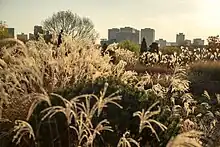
Daejeon citizens are recognized for their fondness of nature, with most mountains, hot springs, and rivers freely open for public use. Many of the city's modern-day traditions, festivals, attractions, and industries are linked in some way to important mountains, rivers, and forests.[4]
There are eight 'beautiful sights' designated by city government, including the mountains Sikjangsan, Bomunsan, Gubongsan (구봉산), Jangtaesan, and Gyejoksan, the lake Daecheonghosu, as well as Yuseong Foot Spa, and Expo Science Park, which includes landmarks such as the Hanbit Tower and Expo Bridge.[51] The Daejeon Hanbat Arboretum, built on the former parking lots of the World Expo, also holds the distinction of being the largest manmade arboretum in Korea.[52]
_Fortress_in_Daejeon%252C_Korea.jpg.webp)
Overlooking Daejeon from the south, Bomunsan Mountain park was established as a park in 1965. The park contains water springs, trails, Buddhist temples, and some heritage sites dating back as far as the Bronze Age. Facilities include a nature healing center, outdoor concert hall, and Daejeon O-World, a theme park which includes Daejeon Zoo, Joy Land, and Flower Land.[53][54] The park is home to 160 species of 600 animals, 17 rides and themed gardens including Sounds garden, Herb Garden, and Rose Garden.[55]
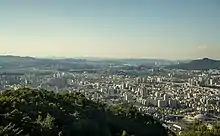
Media
Daejeon is a provincial center for the television, newspaper and publishing industries. Major television broadcasting companies, such as KBS and MBC, have branches in Daejeon; Taejon Broadcasting Corporation (TJB) is a local television broadcaster based in Daejeon. Cable TV services are available in most apartments. Eight (8) channels of Mobile TV are provided with the digital radio channels. Several FM radio stations provide news and music on the air. KBS, MBC, TJB have their FM radio channels, there are Christian radio channels, FEBC and CBS, and traffic news channel TBN. Daejeon Ilbo is the major local newspaper which covers South Chungcheong province.
Festivals
Daejeon Science Festival, which symbolizes the science city of Daejeon, is a representative festival. Other yearly festivals include The Hyo Culture Root Festival, Daejeon International Wine Fair, Yuseong Oncheon Festival, Geumgang Rojas Festival, Diku Festival, Gyejoksan Mountain Manbal Festival and Gyeonwoojik Women Festival.[56]
Sports
Daejeon is home to multiple professional teams and national and internationally active sports facilities. The Daejeon World Cup Stadium was constructed for the 2002 FIFA World Cup, hosting several games including the South Korea vs. Italy match in the round of 16.[57] The facility is now the home of the city's football club. The Daejeon Hanbat Sports Complex was built in 1964, and was one of the host sites of the 1986 Asian Games, and also hosted preliminaries during the 1988 Olympic Games in Seoul. Today, with several of the facilities renovated, it hosts the city's professional baseball, K3 League football, and volleyball teams. The city is also home to LPGA golfers Pak Se-ri and Jang Jeong, and is the hometown of former New York Mets left-handed reliever Dae-sung Koo.
Football
The city is home to the K League 1 football club Daejeon Hana Citizen, playing home games at Daejeon World Cup Stadium, and the K3 League side Daejeon Korail, which plays home games at Daejeon Hanbat Sports Complex.
Baseball
The Hanwha Eagles of the KBO League were founded in Daejeon in 1985. They play home games at the Daejeon Hanbat Baseball Stadium, built in Busa-dong in 1964, with an iconic view of Bomunsan mountain in the outfield. The stadium was renovated and expanded in 2013, moving the outfield wall and expanding seating to 13,000.[58]
Volleyball
The V-League men's volleyball club Daejeon Samsung Fire Bluefangs and the V-League women's volleyball club Daejeon KGC both play their home games at the Chungmu Gymnasium of the Daejeon Hanbat Sports Complex.
Transportation
Daejeon is a center of transportation in South Korea, where two major expressways, Gyeongbu Expressway and Honam Expressway Branch, and two major railway lines, Gyeongbu railway and Honam railway, are joined. Travel time between Daejeon and Seoul using the KTX high-speed rail system is about 50 minutes. The nearest airport to Daejeon is Cheongju Airport, about a thirty-minute drive north of Daejeon. However, there are also direct bus connections to Incheon International Airport.
Subway
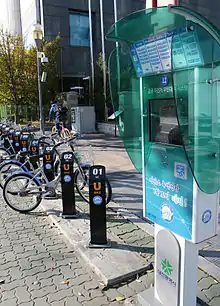
One line, Daejeon Subway Line 1, of a planned five-line subway system has been operating since 17 April 2007 (partial operations on this line began on 16 March 2006). This subway line connects Daejeon Station, located in the original city center, with the more modern and more recently developed sections of this city, including Dunsan, where the city hall and a number of national government buildings are located.
Notable differences between the Daejeon subway and the Seoul subway include narrower cars, no doors connecting cars, four cars per train rather than ten, and storage space under the seats for use by passengers.[59] Originally, plastic tokens for toll were read by a proximity sensor when entering the turnstiles, and then inserted into a slot when exiting. The design of the tokens allowed them to be used for advertising.[60] The system now employs the T-money system, a rechargeable series of Smart cards and other "smart" devices used for paying transportation fares. Platform screen doors are installed in the subway stations.
Cycling
The name of the public bicycle in Korea is different for each region, and the name of the public bicycle in Daejeon is '타슈(Tashu)'[61]. '타슈(Tashu) is a name created using the Chungcheong dialect, and if changed to standard Korean, it becomes '타세요(Taseyo)'. Tashu is an unmanned rental public bicycle service operated in Daejeon Metropolitan City since 2008, and the basic rental fee is 500 won, and if one purchases a daily ticket, the bicycle can be used unlimitedly within an hour on that day. In other words, if you return it within an hour of rental, you can re-rent it for free immediately after returning it and use it for another hour. However, if it exceeds one hour, an extra fee will be automatically charged. The rental time is from 5 a.m. to 0 a.m., and rental is not possible from 0 a.m. to 5 a.m., and only return is possible. The name '타슈(Tashu)' is considered a good example of branding because it is a good name for anyone in the world to pronounce while maintaining their local identity.
Gallery
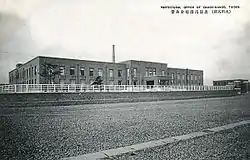 South Chuncheong Provincial Office in 1920s
South Chuncheong Provincial Office in 1920s Government offices for the South Chungcheong province in 2007
Government offices for the South Chungcheong province in 2007 Daejeon Station in 1920s
Daejeon Station in 1920s Daejeon train station in 2007
Daejeon train station in 2007![Daejeon O-World [ko]](../I/Daejeon_Zooland.JPG.webp) Daejeon O-World
Daejeon O-World Uam Historic Park
Uam Historic Park Pyeongsong Youth Cultural Center and blocks of flats of Dunsan-dong district from Lotte City Hotel Daejeon in 2020
Pyeongsong Youth Cultural Center and blocks of flats of Dunsan-dong district from Lotte City Hotel Daejeon in 2020 Mokcheok Bridge
Mokcheok Bridge Immigration office
Immigration office View of Daejeon from Sikjang Mountain, with Dong-gu in the foreground
View of Daejeon from Sikjang Mountain, with Dong-gu in the foreground
Notable people
- An Yu-jin, singer (Iz*One, Ive)
- Kim Joon-ho, comedian
- Do Ji-han, actor
- Choi Sung-bong, singer
- Chung Eun-yong, policeman and activist
- Han Eun-jung, actress
- Yoon Joo-hee, actress
- Han Sang-hyuk, singer (VIXX)
- Hong Jin-ho, television personality and former professional StarCraft player
- Ivy, singer and musical actress
- Kwon Sang-woo, actor
- Lee Na-eun, singer and actress (April), born in Cheongju (청주). She moved to Daejeon before entering elementary school.
- Lee Yoon-ki, film director
- Lim Choong-hyun, footballer
- Rhie Won-bok, cartoonist
- Pak Se-ri, former professional golfer
- Joon Park, artist
- Ryu Su-jeong, singer (Lovelyz)
- Shin Chaeho, independence activist, historian, anarchist, nationalist and the founder of Korean ethnic nationalist historiography
- Shin Seung-hun, singer-songwriter
- Song Joong-ki, actor
- Chen, singer, dancer, model and member of (EXO, EXO-CBX)
- Kyu Ha Kim, judoka
- Baek Ye-rin, singer (15&)
- Park Ji-min, singer (15&)
- Jo Bo-ah, actress, model and host
- Park Eun-ooh, singer-songwriter, music producer, vocalist and lyricist
- Son Suk-ku, actor
- Choi Jung-in, singer
- Kim Woo-seok, singer (X1, Up10tion) and actor
- FlaSh, StarCraft: Brood War and StarCraft II player
- Paul Sun-Hyung Lee, actor
- Kim Dong-hyun, singer (AB6IX)
- Yeo One, singer (Pentagon) and actor
- Kwak Dong-yeon, actor
- Lee Hae-in, figure skater
- Kim Duk-soo, traditional musician[62]
Twin towns – sister cities
| City | Region | Country | Year |
|---|---|---|---|
| Oda | 1987 | ||
| Seattle | 1989 | ||
| Budapest | 1994 | ||
| Nanjing | Jiangsu[63] | 1994 | |
| Calgary | 1996 | ||
| Guadalajara[64] | 1997 | ||
| Uppsala | 1999 | ||
| Novosibirsk | 2001 | ||
| Brisbane | 2002 | ||
| Bình Dương Province[63] | 2005 | ||
| Sapporo | 2010 | ||
| Durban | 2011 | ||
| Purwokerto | 2014 | ||
| Bandung | 2015 | ||
| Siem Reap | Siem Reap Province[63] | 2019 | |
See also
References
Citations
- "2021년 지역소득(잠정)".
- "Timelines Explorer – Data Commons". datacommons.org. Archived from the original on 16 November 2021. Retrieved 18 November 2021.
- "12 Attractions of Daejeon". Daejeon Metropolitan City Culture and Tourism. Archived from the original on 8 May 2018. Retrieved 18 November 2021.
- Kim, Yong-jae (1993). Hanbit Tower and A Song of Asterism: A Literary Anthology For the Taejon EXPO'93. Daejeon: Moonkyoung Publishing.
- "KTX Train Schedule | From Seoul to Daejeon". KTX TRAINS. Archived from the original on 20 April 2021. Retrieved 26 March 2021.
- "Welcome to Daejeon Metropolitan City". 18 November 2006. Archived from the original on 18 November 2006. Retrieved 3 October 2022.
- Kang, Byung Sam (2021). The Road to Korea – Science & Technology Park. Korea Innovation Foundation. pp. 31, 60, 67. ISBN 979-11-976808-1-6.
- "Daejeon Metropolitan City: About Daejeon". Archived from the original on 9 July 2015. Retrieved 7 August 2015.
- "근대의대전". Archived from the original on 3 October 2022. Retrieved 3 October 2022.
- "Government Buildings Management Office". gbmo.go.kr (in Korean). Archived from the original on 26 June 2022. Retrieved 3 October 2022.
- Song-Du-Bum (July 2000). "Scientific-industrial and nucleus administrative city, Daejeon". GukTo(country). 7 (225): 70. Archived from the original on 3 December 2013. Retrieved 7 April 2013.
- "현대의대전". Archived from the original on 3 October 2022. Retrieved 3 October 2022.
- "위치 | 대전광역시청". 11 July 2022. Archived from the original on 11 July 2022. Retrieved 3 October 2022.
{{cite web}}: CS1 maint: bot: original URL status unknown (link) - 선사시대의대전 [Prehistoric War] (in Korean). Daejeon.go.kr. Archived from the original on 13 January 2014. Retrieved 22 March 2014.
- EB (1878), p. 390.
- "데덴찌? 전국 손바닥 편 가르기 구호 총정리 / 스브스뉴스" [Dedenzzi? National team division slogans / SBS News]. Archived from the original on 12 December 2021 – via YouTube.
- Winnington, Alan (1950). I Saw Truth in Korea. People's Press Printing Society. Archived from the original on 14 July 2023. Retrieved 3 August 2021.
- Shaw, Tony (1999). "The Information Research Department of the British Foreign Office and the Korean War, 1950–53". Journal of Contemporary History. 34 (2): 269. doi:10.1177/002200949903400206. JSTOR 261219. S2CID 159855506.
- "Correspondent Alan Winnington". New Statesman. 113: 15. 1987. Archived from the original on 14 July 2023. Retrieved 29 December 2020.
- Jenks, John (2006). British Propaganda and News Media in the Cold War (International Communications). Edinburgh: Edinburgh University Press. p. 55. ISBN 0748623140.
- Oh, Changyeop (22 March 2006). "Daejeon, Larger Population than Gwangju". Prometheus (in Korean). Archived from the original on 28 September 2007. Retrieved 22 February 2007.
이러한 대전의 인구증가 요인은 지난 1998년 정부대전청사 이전과 한국철도공사, 특허법원, 대덕연구단지 등이 자리를 잡은 것과 관련이 있다.
- "지형여건 | 대전광역시청". 8 August 2022. Archived from the original on 8 August 2022. Retrieved 3 October 2022.
{{cite web}}: CS1 maint: bot: original URL status unknown (link) - "Archived copy" (PDF). 29 January 2022. Archived from the original on 29 January 2022. Retrieved 3 October 2022.
{{cite web}}: CS1 maint: archived copy as title (link) CS1 maint: bot: original URL status unknown (link) - "Climatological Normals of Korea (1991 ~ 2020)" (PDF) (in Korean). Korea Meteorological Administration. Archived from the original (PDF) on 29 January 2022. Retrieved 4 April 2022.
- 순위값 – 구역별조회 (in Korean). Korea Meteorological Administration. Archived from the original on 7 October 2021. Retrieved 4 April 2022.
- "Climatological Normals of Korea" (PDF). Korea Meteorological Administration. 2011. Archived from the original (PDF) on 7 December 2016. Retrieved 8 December 2016.
- "Daejeon, South Korea – Detailed climate information and monthly weather forecast". Weather Atlas. Yu Media Group. Archived from the original on 19 September 2020. Retrieved 9 July 2019.
- "행정구역 | 대전광역시청". 6 September 2022. Archived from the original on 6 September 2022. Retrieved 3 October 2022.
{{cite web}}: CS1 maint: bot: original URL status unknown (link) - 송, 한경 (19 April 2023). "2023년 1분기 주민등록인구통계". Daejeon Metropolitan City. Daejeon Metropolitan City Policy Planning Department. Archived from the original on 1 May 2023. Retrieved 2 May 2023.
- "Daejeon Population statistics". Archived from the original on 14 July 2023. Retrieved 14 March 2022.
- 2005 Census – Religion Results Archived 4 September 2015 at the Wayback Machine
- "53rd Daejeon Statistical Yearbook, 2014". 23 March 2014. Archived from the original on 3 March 2016.
- "Asia's Best Universities 2000". Asiaweek. 30 June 2000. Archived from the original on 20 February 2007. Retrieved 21 February 2007.
- "Daejeon Science High School" (in Korean). Archived from the original on 24 March 2007. Retrieved 21 February 2007. High schools in South Korea usually do not require special entrance exams.
- "Korea's Largest R&D Hub | Daejeon". www.investkorea.org. Archived from the original on 2 May 2023. Retrieved 2 May 2023.
- "Research Centers". www.ibs.re.kr. Archived from the original on 2 May 2023. Retrieved 2 May 2023.
- "NFRI Index". Archived from the original on 22 February 2018. Retrieved 7 August 2020.
- 공감코리아(sympathyKorea) (21 March 2012). "Management Division International Science and Business Belt implementation plan, 2012". 공감코리아(sympathyKorea) archive. publish in book form: 1–93 [4]. Archived from the original on 8 April 2013. Retrieved 7 April 2013.
- "Hankook Tire Review – Enfren Tires". Trucktrend.com. 17 December 2008. Archived from the original on 6 March 2014. Retrieved 22 March 2014.
- "대전시립미술관". terms.naver.com (in Korean). Archived from the original on 3 October 2022. Retrieved 3 October 2022.
- "Daejeon Arts and Culture Center". Archived from the original on 3 October 2022. Retrieved 3 October 2022.
- "Lee Ungno Museum, Daejeon, South Korea". Google Arts & Culture. Archived from the original on 3 October 2022. Retrieved 3 October 2022.
- "History". National Science Museum of Korea. Archived from the original on 29 August 2007. Retrieved 28 February 2007.
- "Exhibition Guide". science.go.kr. Archived from the original on 25 June 2022. Retrieved 10 May 2022.
- "Campus Map". science.go.kr. Archived from the original on 10 May 2022. Retrieved 10 May 2022.
- "Information on Relocation of IBS HQ". ibs.re.kr. HQ Relocation Team. 21 December 2017. Archived from the original on 12 June 2018. Retrieved 17 January 2018.
- "Archived copy". 6 May 2006. Archived from the original on 6 May 2006. Retrieved 10 May 2022.
{{cite web}}: CS1 maint: archived copy as title (link) - "대전시민천문대". djstar.kr (in Korean). Archived from the original on 9 May 2022. Retrieved 10 May 2022.
- "대전문화재단 – 대전예술가의 집 – 소개". dcaf.or.kr (in Korean). Archived from the original on 4 December 2021. Retrieved 4 December 2021.
- "대전광역시 동구 관광문화축제". donggu.go.kr (in Korean). Archived from the original on 21 June 2022. Retrieved 10 May 2022.
- 8 good places Archived 2 March 2009 at the Wayback Machine
- 이, 천열 (12 May 2009). "9일 개장 국내 최대 인공 '대전 한밭수목원' 가보니". 서울신문. Archived from the original on 1 February 2014. Retrieved 20 August 2021.
- 문화관광, 대전 중구. "보문산 > 중구 10경 > 가보고 싶은 그 곳, 중구 >". djjunggu.go.kr (in Korean). Archived from the original on 3 October 2022. Retrieved 3 October 2022.
- "Destinations by Region : VisitKorea Destinations by Region Bomunsan Forest Trail (보문산 행복 숲 둘레길) | Official Korea Tourism Organization". english.visitkorea.or.kr. Archived from the original on 3 October 2022. Retrieved 3 October 2022.
- "대전 오월드". oworld.kr. Archived from the original on 29 May 2022. Retrieved 10 May 2022.
- "대전관광". daejeon.go.kr. Archived from the original on 29 November 2018. Retrieved 31 May 2019.
- "South Korea – Italy 2:1 (World Cup 2002 Japan/South Korea, Round of 16)". worldfootball.net. Archived from the original on 11 August 2018. Retrieved 29 October 2022.
- "한밭야구장". 대전광역시. Archived from the original on 14 May 2022. Retrieved 3 May 2022.
- "Riding Daejeon Subway". iris's talk on above 18 & computers & and society (in Korean). 8 May 2006. Archived from the original on 16 May 2007. Retrieved 28 February 2007.
- "Visiting Daejeon Subway". Korean Faction (in Korean). 17 March 2006. Archived from the original on 3 January 2007. Retrieved 28 February 2007.
뒷면에는 대전소재 배재대학교의 광고가 새겨져있었습니다.
- "What is Tashu?". Archived from the original on 29 November 2021. Retrieved 25 October 2021.
- Boram, Kim (11 May 2020). "Korean 'samulnori' master Kim Duk-soo stars in biographical musical". Yonhap News Agency. Retrieved 20 October 2023.
- These subdivisions do not have their own flags.
- "Sister Cities, Public Relations". Guadalajara municipal government. Archived from the original on 2 March 2012. Retrieved 12 March 2013.
Bibliography
- , Encyclopædia Britannica, 9th ed., Vol. VI, New York: Charles Scribner's Sons, 1878, pp. 390–394.
External links
- Official website (in English)
- Daejeon: Official site of Korea Tourism Org. (archived)


.jpg.webp)

